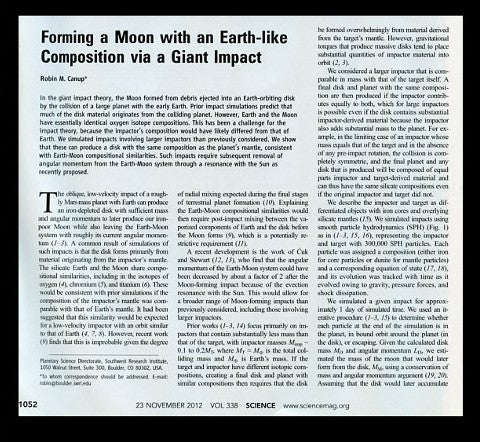Forming a Moon with an Earth-like composition via a Giant Impact (Canup, pp. 1052-1055) WITH Making the Moon From a Fast-Spinning Earth: A Giant Impact Followed by Resonant Despinning ( uk, pp. 1047-1052 in Science 338, 6110, November 23, 2012
New York: AAAS, 2012. 1st Edition. FIRST EDITION IN ORIGINAL WRAPS OF TWO IMPORTANT PAPERS ON THE GIANT-IMPACT THEORY, THE CURRENTLY FAVORED SCIENTIFIC HYPOTHESIS FOR THE FORMATION OF THE MOON. The Giant-Impact Theory is also know as the Giant-Impact Hypothesis, the Big Splash, and the The Impact.
“The giant impact believed to have formed the Earth-Moon system has long been accepted as canon. However, a major challenge to the theory has been that the Earth and Moon have identical oxygen isotope compositions, even though earlier impact models indicated they should differ substantially” (Phys Org Web Portal, 17 October 2012). The significance of Canup’s paper is that it “accounts for this similarity in composition while also yielding an appropriate mass for Earth and the Moon” (ibid).
Motivated by the work of others on the early dynamical history of the Moon, Robin Canup, working at the Southwest Research Institute in Boulder, CO, developed new models that involve much larger impactors than were previously considered. In the new simulations, both the impactor and the target are of comparable mass, with each containing about 4 to 5 times the mass of Mars. The near symmetry of the collision causes the disk's composition to be extremely similar to that of the final planet's mantle over a relatively broad range of impact angles and speeds, consistent with the Earth-Moon compositional similarities. The new impacts produce an Earth that is rotating 2 to 2.5 times faster than implied by the current angular momentum of the Earth-Moon system, which is contained in both the Earth's rotation and the Moon's orbit” (PHYS ORG, New Model, Oct. 17, 2012).
WITHBOUND: This paper by Dr. Matija uk, SETI Institute, and Dr. Sarah T. Stewart at Harvard University proposed that the angular momentum of the early Earth was larger than the present day system. If so, different types of impact events could generate a lunar disk from the same materials that formed the young Earth’s mantle. After the impact, an orbital resonance transferred angular momentum away from the Earth-Moon system to reach the present day value” (Stewart, Origin of the Earth and Moon, Web Portal).
In other words, in addition to the impacts identified in Canup's paper, uk and Stewart show that impacts involving a much smaller, high-velocity impactor colliding into a target that is rotating very rapidly due to a prior impact can also produce a disk-planet system with similar compositions.
"The ultimate likelihood of each impact scenario will need to be assessed by improved models of terrestrial planet formation, as well as by a better understanding of the conditions required for the evection resonance mechanism” (ibid). Item #1193
CONDITION & DETAILS: New York: AAAS. Complete 1st edition in original wraps, complete. 8vo. Fine condition. Pristine.
Price: $185.00

